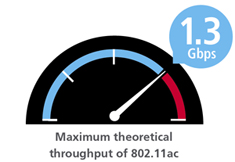Why 802.11ac Wi-Fi Networks Appeal to Agencies
As host to the Southern Conference Basketball Tournament in 2013 and 2014, the city of Asheville, N.C., is closely following an emerging wireless standard that promises to bring gigabit speeds to Wi-Fi networks.
Dubbed 802.11ac, the next-generation standard could enhance the civic center’s ability to provide video streaming to the press. “Our venue has some of the best wireless that ESPN reporters have ever seen, and we would like to keep it that way,” says Jonathan Feldman, director of IT services for the city of Asheville.
The civic center has an 802.11n Wi-Fi network that provides megabit speeds to reporters and fans. Feldman will consider upgrading it to 802.11ac in 2014.
Enhanced support for video is one of the drivers behind the development of 802.11ac, which is winding its way through the Institute of Electrical and Electronics Engineers (IEEE) standards process and is on track to be approved early next year.
New and Improved
The new standard upgrades 802.11n technology, which can use either 2.4 gigahertz or 5GHz frequency bands. 802.11ac operates only on the 5GHz band, which contains more available channels than the 2.4GHz band. Additionally, 802.11ac uses wider 80 megahertz channels instead of the 40MHz channels used by Wireless N.
Besides speed, other anticipated benefits of 11ac include faster throughput for streaming video, higher capacity to support more wireless devices, broader coverage from a single access point (AP) and longer battery life for wireless devices.
Several hardware manufacturers have begun to release 11ac-compatible products. For example, Cisco’s Aironet 3600 AP offers a slot for users to add 11ac modules when the standard is approved. Netgear ships an R6300 Wi-Fi router that supports the new standard, and Buffalo’s AirStation AC1300 router offers support for the 2.0 draft.
Ample Availability
"As of around the middle of next year, we expect that most enterprise-class vendors will have 802.11ac products,’’ says Craig Mathias, a principal at wireless consultancy Farpoint Group. Organizations that need new Wi-Fi systems should purchase 802.11n gear now rather than waiting for 802.11ac, Mathias recommends. Nonetheless, 802.11ac is poised to bring many benefits to state and local governments, including performance that will initially be twice as fast as Wireless N.
“The typical benchmarks we see for 802.11n networks are 200-plus megabits,” Mathias says. “We would expect for 802.11ac to see double that. But a lot will depend on what infrastructure you have and how you configure it.” Many potential applications exist for 802.11ac Wi-Fi, including public buildings, airports, courts, surveillance and public safety systems. Stephen Orr, distinguished systems engineer with Cisco’s U.S. public sector group, says the technology will benefit any agency using Wi-Fi to transmit video. “802.11ac will allow you have to have multiple high-definition data streams on your wireless APs,” Orr says. The emerging standard can also better accommodate the traffic load generated by bring your own device initiatives.
Back in Asheville, Feldman isn’t standing still waiting for 802.11ac products in order to provide the best possible video streaming at the city’s civic center. “We’ve got areas where the reporters can get to a wired network to upload all their photos and video,” he says. “And we’re using traffic shaping today so one person watching Netflix is not destroying the wireless connectivity for everyone else.”








